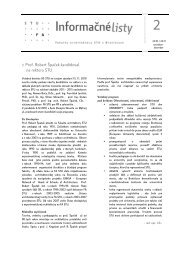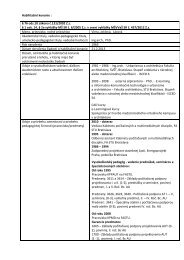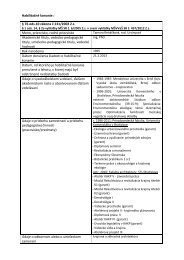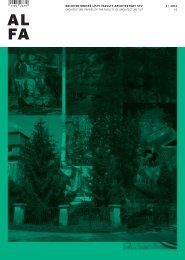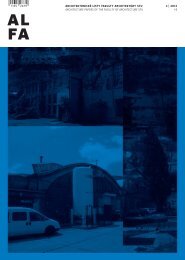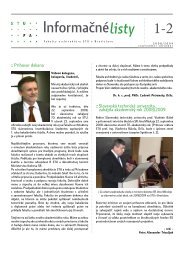ALFA 3-4/2005 - Fakulta architektúry STU
ALFA 3-4/2005 - Fakulta architektúry STU
ALFA 3-4/2005 - Fakulta architektúry STU
Create successful ePaper yourself
Turn your PDF publications into a flip-book with our unique Google optimized e-Paper software.
Ročník 9<br />
3-4 / <strong>2005</strong> ARCHITEKTONICKÉ LISTY FA <strong>STU</strong><br />
Thanks to the mass production, Thonet chairs can be considered<br />
an industrial product and therefore a promoter of the Modern<br />
chair. Modernism, which is characteristic for the 20 th Century, is<br />
not a style but a philosophical movement which promotes<br />
a classical and humanizing ideology that can be applied to<br />
furniture design. The tenets of modernism are the unification of<br />
the physical and the spiritual; the harmonizing of functional and<br />
aesthetic; internationalism through abstraction; innovation; truth to<br />
materials; revealed construction and the responsible use of<br />
technology. Within Modernism there are two different aproaches<br />
to design: geometric abstraction and organic abstraction.<br />
Geometric abstraction was promoted by the pioneers of<br />
the Modern Movement such as Marcel Breuer, Ludwig Mies van<br />
der Rohe and Le Corbusier. The second aproach was founded in<br />
the work of Scandinavian designers influenced by teachings of<br />
Kaare Klint such as Alvar Aalto or Eero Saarinen.<br />
Except of different movements and approaches there are three<br />
technological phases highly influential to the design evolution<br />
during the 20 th Century: the bending of metal tubes (1925),<br />
laminating of wood (1931) and moulding of plastic materials<br />
(1948). They were not only of practical importance but they also<br />
played their role with regards to formal inspiration. The very new<br />
artistic solutions and approaches to the design were supported by<br />
the above mentioned technological discoveries.<br />
As it was mentioned at the beginning, the 20 th Century can be<br />
seen as very progressive in evolution of the chair design.<br />
Thousands of chair designs have been created with different<br />
success. Some of them were more successfull, some of them<br />
less. In this uncountable mass of chair designs, the most<br />
influential master pieces have also been created. These chairs<br />
became the icons of the 20 th Century design.<br />
The “Red-and-blue-chair” designed by Gerrit Rietveld in 1917/18<br />
is generally regarded as the first truly Modern chair. Although<br />
Rietveld did not incorporate new materials or construction<br />
- 44 -<br />
techniques in this chair design, with its simple geometric plans<br />
without traditional upholstery he broke all existing rules. Its design<br />
suggested that a chair did not need to have the visual and material<br />
weight that had associated traditional furniture with luxury and<br />
high cost. The “Red-and-blue-chair” was shown at a general<br />
exhibition at the Bauhaus in 1923 as the first chair to express<br />
a radical Modern ideology.<br />
Marcel Breuer has the primacy. In 1925 he created “B3-Wassily”<br />
which was the first armchair using bent tubular steel. This chair<br />
design was meant an aesthetic turning point in furniture<br />
production as well as the start of an important branch of industry.<br />
The most important innovation of Breuer’s designs lay not only in<br />
using tubular steel but also in reducing the basic design from<br />
a traditional heavy club armchair to a light frame. In “B3-Wassily”<br />
design is possible to find influence of Gerrit Rietveld’s furniture.<br />
This chair was originally created for Wassily Kandinsky’s Bauhaus<br />
studio, so it can be seen like integral part of unified interior design.<br />
Barcelona chair designed in 1929 by Ludwig Mies van der Rohe<br />
for the German pavilon at the Barcelona world’s fair, had been an<br />
integral part of unified interior scheme as well. The fact that<br />
the chair designs of two “founding fathers” of the Modern<br />
Movement have been created like integral part of unified<br />
architectural design ironically ran counter to modern philosophy.<br />
But with a step of time these designs can be evaluated like<br />
Modern thanks to their later great universality.<br />
Like revolutional can be seen Mart Stam’s chair that uses<br />
the architectural cantilever principle. Stam’s chair was the first<br />
of its kind, later followed by well known designers like Ludwig Mies<br />
van der Rohe (“Model No. MR 10”) or Marcel Breuer (“Model<br />
No. B32 – Cesca” and “Model No. B33”). All these were<br />
constructed from resilient bent tubular steel without back legs.<br />
If bent tubular steel furniture is mentioned, Le Corbusier’s (in<br />
cooperation with Ch. Perrand) designs have to be lifted. His<br />
“Grand confort” and the “Model No. 2072 – chaise longue” (called<br />
also “machine for resting”) used the combination of tubular metal<br />
and leather.<br />
Different way of design in comparison with Bauhaus, mentioned<br />
above, is the style of Scandinavian designers. Their approach to<br />
Modernism is based on the use of natural woods and other<br />
organic materials. The technology of wood lamination enabled<br />
Alvar Aalto to create his bent laminated wood “Paimio chair” in<br />
1931. This method of wood processing had enabled the return to<br />
the more sculptural approach to design, which was later<br />
perceptible in the works of Bruno Mathsson or Arne Jacobsen.<br />
The Second World War had an enormous impact on the furniture<br />
industry. The enormous increase of research during wartime as<br />
well as development in other manufacturing fields, especially<br />
the aircraft industry, meant that furniture industry and designers<br />
had an opportunity to use the latest and most efficient technologies<br />
for the production after the war. Using former military purpose data



